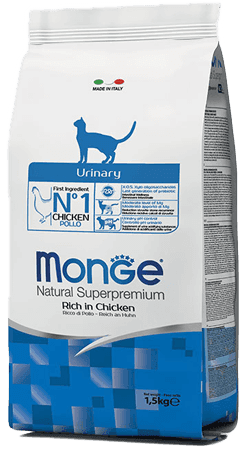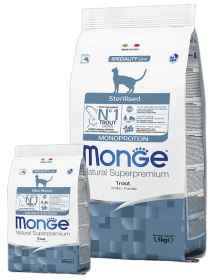Monge
Urinary Chicken
Adult
Urinary
Indoor and Outdoor
Click to reveal the score breakdown
Tap to view ingredients, guaranteed analysis and more
Ingredients
Rice
Corn gluten
Chicken (fresh meat)
5%
Chicken (dehydrated )
18%
Dried fish (salmon)
Animal fat (chicken fat preserved with natural antioxidants),
99.6%
Oats
Hydrolysed animal proteins
Dried peas
Dried eggs
and also:
Fish oil (salmon oil), Xylo-Oligosaccharides (XOS) (3g/kg), Mannan oligo saccharide, Yucca schidigera.
Vitamins and Additives
Vitamin A 27000 IU
Vitamin B1 22 mg
Vitamin B2 0.2 mg
Vitamin B6 14 mg
Vitamin B12 0.2 mg
Vitamin C 360 mg
Vitamin D3 1500 IU
Vitamin E 510 mg
and also:
Biotin (0.57mg), Niacin (100mg), Pantothenic Acid (22mg), Folic Acid (31mg), Choline Chloride (2500mg), E5 Manganous Sulphate Monohydrate (56mg), E6 Zinc Oxide (260mg), E4 Copper Sulphate Pentahydrate (22mg), E1 Iron Sulphate Monohydrate (185mg), E8 Sodium Selenite (0.37mg), E2 Calcium Iodate (2.8mg), L-Carnitine (500mg), DL-methionine technically pure (3gr), Taurine (0.25IU)
Guaranteed Analysis
Crude Protein
31%
Crude Fat
16%
Crude Fiber
2.5%
Crude Ash
5%
Calcium
0.8%
Phosphorus
0.8%
Potassium
1.2%
Magnesium
0.07%
Omega 3
1%
Omega 6
4.5%
Metabolizable Energy
4100 kcal/kg
Product last updated: April 29, 2023, 10:33 AM
Please hold on while we’re getting the best offers for you
7484












